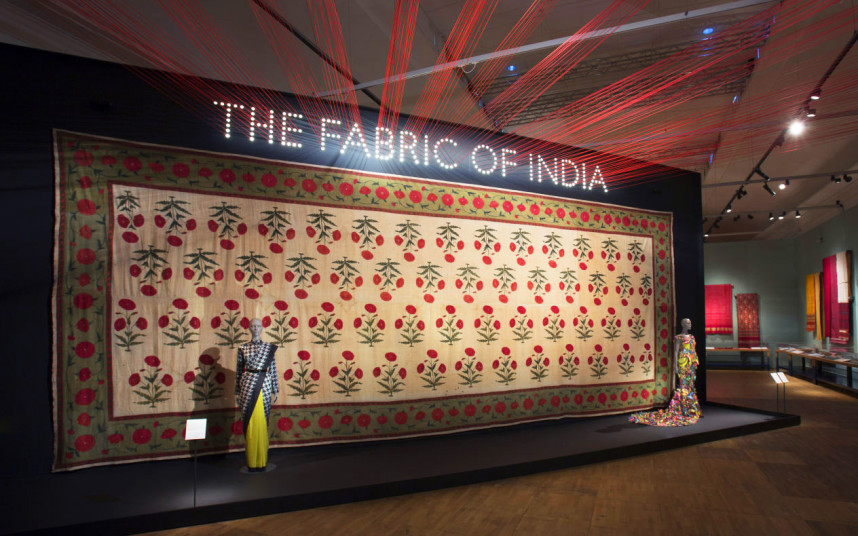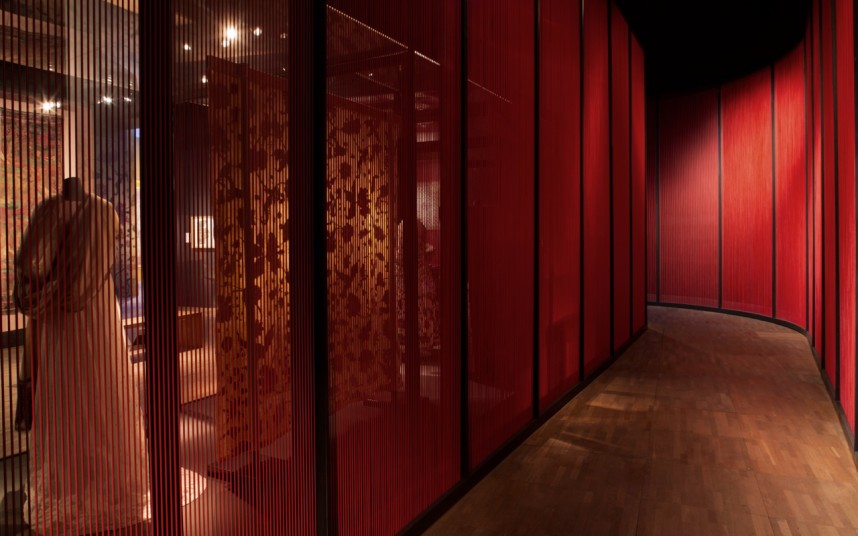
Installation view of ‘The Fabric of India’ exhibition, 3 October 2015 – 10 January 2016
Gitta Gschwendtner – who is developing a furniture commission for the new Cancer Centre at Guy’s Hospital Arts Programme, curated and delivered by Futurecity – has created the exhibition design for the The Fabric of India at the Victoria & Albert Museum. This is the museum’s first major show exploring the dynamic and multifaceted world of handmade textiles from India from the 3rd – 21st centuries. It is on now and runs until 10th January 2016.
One of the main exhibition design concepts is the use of string, inspired by the thread on the weaving loom. At the entrance a dramatic installation has red thread projection from the title font. Further along a red bungee corridor connects two galleries, creating a stunning passage that allows glimpses through the string into the adjoining space. In the final gallery blue bungee is used to create a screen separating two fashion sections. The vertical string changes its opacity depending on the viewing angle, creating changing transparency as well as different intensities of the blue thread. In order to create further continuity between sections, Gitta Gschwendtner’s design uses trays to display objects, create walls and plinth. The tray develops into a design language that is subtle, yet recognizable, creating containers, frames and parameters.

In the first section, “Nature and Making”, plain mdf creates the backdrop for a display based on basic workshop environments. In the “Sacred” section aged copper and copper coloured walls allude to temples, churches and mosques. Further along “Splendid” explores the magnificent architecture of palaces through yellow stained mdf and sky blue lighting. In “A Global Trade” a dark environment with bright red case interiors recreates the mystery of foreign trade routes. The section “Textile in a Changing World” uses grey stained mdf to bring a more contemporary feel to the exhibition, referencing concrete and also introducing fins into the tray structure. The final section, “Cutting Edge”, uses an even darker stained mdf in combination with aged zinc, creating tray catwalks for the fashion mannequins.
Gschwendtner’s furniture commission for the new Cancer Centre at Guy’s Hospital Arts Programme, Genius Loci, responds to patient and staff research, and a desire to provide some privacy for cancer patients and their relatives within the open spaces of the ‘welcome’ areas of each treatment ‘village’ in the new building, currently under construction. Gschwendtner has developed a series of seating clusters with extended metal mesh screens, which in turn support floating upholstered seats in vibrant colours.
The cluster series creates open seats and inward-looking spaces for one or two people and booths for larger groups. Together they add playful layers of nuanced colour to the space as well as creating private environments for patients and staff to meet. The varied heights of the screens, some of which extend across the floors and are at full atrium height, create swooping, dramatic lines – making a striking contribution to the architect Rogers Stirk Harbour + Partners’ and the interior architect Stantec’s use of colour throughout the building.
The Cancer Centre Arts Programme is funded by Guy’s and St Thomas’ Charity and is an integral part of the new Cancer Centre developed by Guy’s and St Thomas’ NHS Foundation Trust. The new Cancer Centre is located in the capital’s London Bridge Quarter and has been designed by Rogers Stirk Harbour + Partners and Stantec. The state-of-the-art building will bring together the majority of Guy’s and St Thomas’ cancer treatment and research under one roof. The Cancer Centre at Guy’s will open to patients in 2016.
Credits:
Exhibition design: Gitta Gschwendtner
Exhibition graphics: Studio Frith
Photography: Sorted
